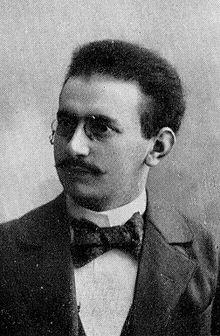Julius Hanauer
Julius Hanauer (born September 21, 1872 in Mannheim , † April 19, 1942 in Łódź ) was a German librarian and Esperantist .
Career
Hanauer was born as the son of the businessman Adolf Hanauer and his wife Hermine, née Kauffmann. He attended the humanistic grammar school and studied at the universities in Würzburg and Berlin as well as at the Technical University of Hanover and the Academy for Social Sciences in Frankfurt am Main. In the years 1895/96 he was assistant to Wilhelm Conrad Röntgen at the Physics Institute of the University of Würzburg. During this time he prepared his doctoral thesis, which he presented in 1896.
Since 1896 he had been in constant correspondence with Wilhelm Ostwald . During his work in Brussels with Paul Otlet and Henri La Fontaine in the “Societé des Etudes Sociales et Politiques”, later “ International Office of Bibliography ”, he got to know the decimal classification . As early as 1918, he had suggested using Hollerith machines to process bibliographic information.
From 1918 to 1935 Hanauer worked in a department of the Allgemeine Elektricitäts-Gesellschaft ( AEG ) in Berlin, which was called the "Literary Office". All company-relevant technical and economic information was collected there. The office also had the function of today's PR agency. At the AEG, Hanauer was nicknamed " Saint Francis of the Decimal Classification".
After learning Esperanto in 1896 , he became vice-chairman of the German Esperanto Association and later an honorary member of the Esperanto group in Frankfurt am Main . He is considered to be the author of the anonymous brochure Germanaj fremdvortradikoj en Esperanto.
Hanauer took part in the 1st Esperanto Congress in 1905 and was elected as one of the 98 members of the language committee (Lingva Komitato). At the 4th Esperanto Congress in Dresden he presented a new type of teaching system for Esperanto. He later developed a teaching method that used film material that he presented at the 1929 World Congress.
Between 1910 and 1913, Hanauer was secretary of a founding organization of the Socialist Abstinence International based in Brussels .
Hanauer was deported from Frankfurt am Main to the Litzmannstadt ghetto on October 20, 1941 , where he became a victim of the Holocaust on April 19, 1942 .
Fonts (selection)
- About the dependence of the capacitance of a capacitor on the frequency of the alternating currents used , Würzburg, Phil. Diss. 1897.
- Decimal classification . In: Zentralblatt für Bibliothekswesen , vol. 45, 1928, pp. 503-514.
- Impressions from the annual meeting of the International Bibliographical Institute (Brussels) on September 17th and 18th, 1928 . In: Börsenblatt für den Deutschen Buchhandel, vol. 95, 1928, no. 295, December 20, 1928, editorial part, pp. 1379-1380 ( online ).
- Magazine problems and their solution in the literary office of AEG , Purmerend: J. Muusses 1928 (Nederlands Instituut voor Documentatie en Registratuur (The Hague): Publicatie; 17).
- Streamline magazine management . In: Zentralblatt für Bibliothekswesen , vol. 49, 1932, pp. 543-547.
literature
- Herrmann AL Degener (Ed.): Degeners Who is it? - 10th edition - Berlin: Degener, 1935
- Joachim C. Martini , Birgit Klein, Judith Freise, Arno Lustiger: Music as a form of spiritual resistance: Jewish musicians 1933-1945; the example of Frankfurt am Main, Volume 1, Brandes & Apsel, Frankfurt am Main, 2010, pp. 183, 267.
Individual evidence
- ↑ Franz Walter : The German Workers' Abstinents Association (DAAB) , in: Franz Walter, Viola Denecke, Regin Corneli: Socialist health and life reform associations . Bonn: Dietz 1991, pp. 203-205
- ^ Julius Hanauer , at the Federal Archives Memorial Book
| personal data | |
|---|---|
| SURNAME | Hanauer, Julius |
| BRIEF DESCRIPTION | German librarian and Esperantist |
| DATE OF BIRTH | September 21, 1872 |
| PLACE OF BIRTH | Mannheim |
| DATE OF DEATH | April 19, 1942 |
| Place of death | Łódź |
